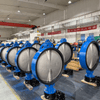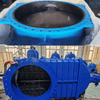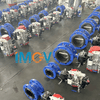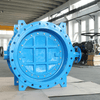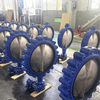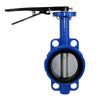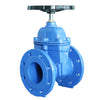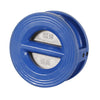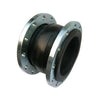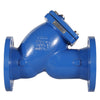Essential Butterfly Valve Knowledge: Do You Know All of These?
In a fluid piping system, valves are control components with key functions such as isolating equipment and piping systems, regulating flow, preventing backflow, and adjusting or releasing pressure. Since valves play an important role in the piping system, it's essential to understand their characteristics and the steps and criteria for selecting the right valve.
1.Butterfly Valve End Connection Types
Lug: The lug-type butterfly valve (LT) has threaded holes, which are directly connected to the pipeline through the threads.
Flange: The flange-type butterfly valve comes with built-in flanges, which are connected to the pipeline flanges on both ends using bolts or other fasteners.
Wafer: The wafer-type butterfly valve uses specialized flanges, and double-ended bolts are used to connect the flange plates and the pipeline.
Butt Weld: Butt welding involves welding the pipes, fittings, flanges, or pipelines together at corresponding diameters.

Socket: Socket connection means that one end of the pipe (often called the socket or bell) has an opening, while the other end (often called the spigot or pipe) has a protruding part. They are connected by inserting the spigot into the bell and using sealing rings or gaskets to ensure a tight seal.

Groove: Grooved connection, also known as clamp connection, involves cutting specific grooves at the pipe ends and using special clamps, rubber gaskets, and bolts to connect two pipes or fittings. These grooves are typically cut to specific shapes and depths on the outer surface of the pipe.

Thread: Threaded connection, also called screw connection, involves connecting pipes or valves through the mutual engagement of internal and external threads.

Socket Weld: Socket welding uses the socket connection method, where the pipe is inserted into the recessed wall of the valve, fitting, or flange and then welded. Unlike butt welding, socket welds are usually applied to small-diameter pipes of DN50 or below.

2.What are the butterfly valve tests?
Material Testing (Rubber): This involves a series of tests and evaluations on rubber materials to ensure that their performance and quality meet the required standards. Key tests include hardness, tensile strength, elongation, compression set, and rubber content.
Material Testing (Metal): Metal testing for valves primarily involves the analysis of the chemical composition to ensure it meets the required specifications.
Physical Properties Test: This includes tests for tensile strength, yield strength, elongation, hardness, and section shrinkage to assess the mechanical properties of the valve material.
Nondestructive Testing (NT): NT refers to inspecting surface and internal defects of the valve without damaging the object or affecting its lifespan. Common nondestructive tests include radiographic testing (RT), ultrasonic testing (UT), penetration testing (PT) for weld seals, magnetic particle testing (MT), and eddy current testing (ECT).
Metallographic Inspection: This test involves using a microscope to observe the microstructure of metal surfaces or sections. By analyzing features such as optical properties, morphology, size, and distribution of structures, the performance and quality of the metal can be evaluated. Key inspection points include organization structure, spheroidization rate (nodularity), pearlite, ferrite, roughness, and finish.
Sealing Test: The sealing test assesses the valve's ability to prevent media leakage at various sealing points, which is one of the most important performance indicators of a valve.
Strength (Shell) Test: This test checks the pressure resistance and integrity of the valve body and cover by applying pressure to the entire valve shell, including connections between the body and cover.
Top Sealing Test: This test evaluates the sealing performance between the valve stem and the valve cover. For valves with a top sealing structure, the test involves sealing the valve ports, filling the valve body with a test medium, and ensuring no visible leakage occurs during the test period.
Fire Test: The fire test evaluates the valve’s ability to function under fire conditions, ensuring that it remains operational in the event of a fire.
Electric Spark Test: This test is used to check the insulation performance and corrosion protection quality of valves and mechanical equipment. It detects defects in the insulating materials inside the valve to ensure good corrosion resistance.
Spectrometer (Stainless Steel Composition Detection): This tool is used to detect the chemical composition of stainless steel components in valves.
Fatigue Life Test: Often referred to as the life test, it simulates real working conditions in a lab to evaluate the valve’s operational lifespan by repeatedly cycling it between fully open and fully closed positions to identify failure modes and predict valve longevity.
Additional tools for inspection include micrometers, vernier calipers, torque wrenches, and devices used for the fatigue life test.
3.Butterfly valve manufacturing technology
The manufacturing technology for valves includes several methods: casting, forging, machining, polishing, cold rolling, hot rolling, rolling, and cold drawing.
Difference Between Casting and Forging:
Casting: In casting, metal is melted into liquid form and poured into a mold. After cooling and solidifying, it forms the desired shape. This process is suitable for complex shapes, especially parts with intricate internal cavities. While casting is cost-effective, it can result in defects.
Forging: Forging involves applying pressure to metal billets using forging machinery, causing plastic deformation to create parts with specific mechanical properties and shapes. Forged parts are typically used for high-load, harsh working conditions, and offer superior mechanical performance compared to cast parts.
Equipment Used in Valve Production:Lathes、Milling machines、Planers、Grinders、Broaching machines、Boring machines
4.Valve Painting
Proper surface treatment can enhance a valve's corrosion resistance, wear resistance, sealing capability, and appearance, ensuring stable performance in harsh environments. Common surface treatment methods include painting, EPOXY spraying, coating, and plating.
Valve painting plays a crucial role in both the production and use of valves, covering the following key aspects:
Protective Function:
- Corrosion resistance: Paint forms a protective layer on the valve's surface, slowing corrosion and extending lifespan.
- Mechanical damage prevention: Paint helps prevent scratches and impacts during transport and use, while also enhancing hardness and wear resistance for valves under frequent stress.
Identification Function:
- Type identification: Colors help quickly distinguish valve types, e.g., red for fire valves, blue for cold water, green for hot water.
- Purpose differentiation: Color schemes or markings indicate specific valve functions, aiding efficient maintenance and repairs.
After painting, the following inspections are conducted:Paint coating thickness inspection、Adhesion inspection

5.Butterfly Valve Shaft and Pin Types
Butterfly valves can be classified based on the structure of the shaft and pin into three types: through shaft with pin, through shaft without pin, and half shaft without pin.

Pinned vs. Without Pin Butterfly Valves:
Pinned butterfly valves consist of a valve body, valve disc, valve stem, pin shaft, sealing ring, and an operating mechanism (such as a handle or a worm gear).
Structural Feature: The valve disc is connected to the valve stem via a pin shaft.
Advantages:
Simple and straightforward structure, with a well-established manufacturing process and lower costs.
Suitable for medium to low pressure, normal temperature conditions where sealing requirements are not very stringent. This connection provides stable operation.
Disadvantages:
The pin shaft can become a weak point for leakage, as sealing this area can be challenging, and long-term use may lead to media leakage.
The pin shaft is prone to corrosion and wear from the media, which can affect the valve’s lifespan and performance.
Structural Feature: The valve disc is connected to the valve stem through a special design, eliminating the traditional pin shaft structure.
Advantages:
Eliminates the risk of leakage at the pin shaft, offering better overall sealing performance and reducing the risk of media leakage.
Since there is no pin shaft, there are fewer issues with wear or corrosion, providing higher reliability and a longer service life, making it more suitable for complex and harsh conditions.
Disadvantages:
The structure is more complex, making manufacturing more difficult and increasing costs compared to pinned butterfly valves.
Through Shaft vs. Half Shaft Butterfly Valves:
Through Shaft Butterfly Valve:
In a through shaft butterfly valve, the valve stem is a continuous, solid shaft, without being divided into upper and lower sections. This design simplifies assembly and makes shaft machining easier. It is often used for larger valve sizes, such as DN800.
In a half shaft butterfly valve, the valve stem is divided into two parts: an upper and a lower shaft. This design complicates assembly and increases production difficulty. Half shaft butterfly valves are commonly used for smaller sizes, such as DN300.
6.Butterfly Valve Seats
The valve seat is a removable component inside the valve, designed to support the valve disc in the fully closed position and form a sealing surface. Typically, the seat diameter corresponds to the valve's maximum flow diameter.
When selecting wafer-type butterfly valves, three common seat types are often discussed: hard back seat, soft grooved seat, and vulcanized seat.

The main difference between these types lies in how the valve body and sealing materials are installed, which is reflected in the valve body design and seat structure.

For more detailed information, refer to the article "Understanding Butterfly Valve Seats: The Differences Between Hard, Soft, and Rubber Lined."
7.Butterfly Valve Types
Butterfly valves can be classified by their structural design into wafer butterfly valve, lug butterfly valve, U-type butterfly valve, flange butterfly valve, double offset (double eccentric)butterfly valve, and triple offset (triple eccentric)butterfly valve types.


8.Butterfly Valve Drive Types
Butterfly valves can be classified by their drive mechanisms into several types, including hand lever, gear box, chain wheel, bare stem, electric, pneumatic, and hydraulic.

This is a brief overview of valve basics. A proper understanding and selection of valves can help maximize the performance of your piping system. For more information, please contact Union Valve. We are a professional valve manufacturer, with products certified by ISO9001:2008, CE, WRAS, ACS (France), EAC (Russia), TUV, and SGS.
Related Article:
- Union Valve: Advanced Equipment & Testing - Achieving Valve Optimal Quality
- Choosing the Right Valves for Efficient Water Supply Systems
- What is Cv? A Guide to Valve Flow Coefficient Explained
- Do you know the 8 common API valve standards?
- Step-by-Step Guide to Perfect Butterfly Valve Installation
- Understanding Butterfly Valve Seats: The Differences Between Hard, Soft and Rubber Lined

-
Posted in
Best-selling wafer butterfly valve, butterfiy valve, butterfly valve knowledge, Butterfly Valve Manufacturer

